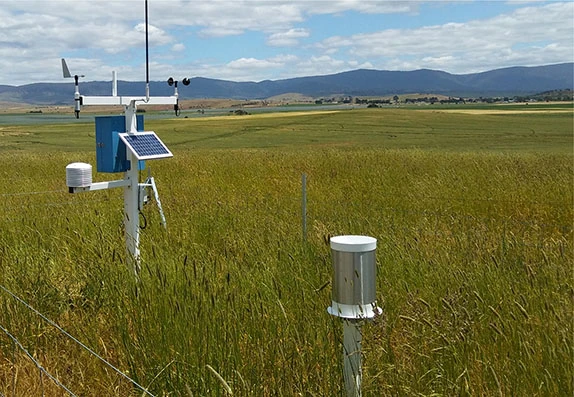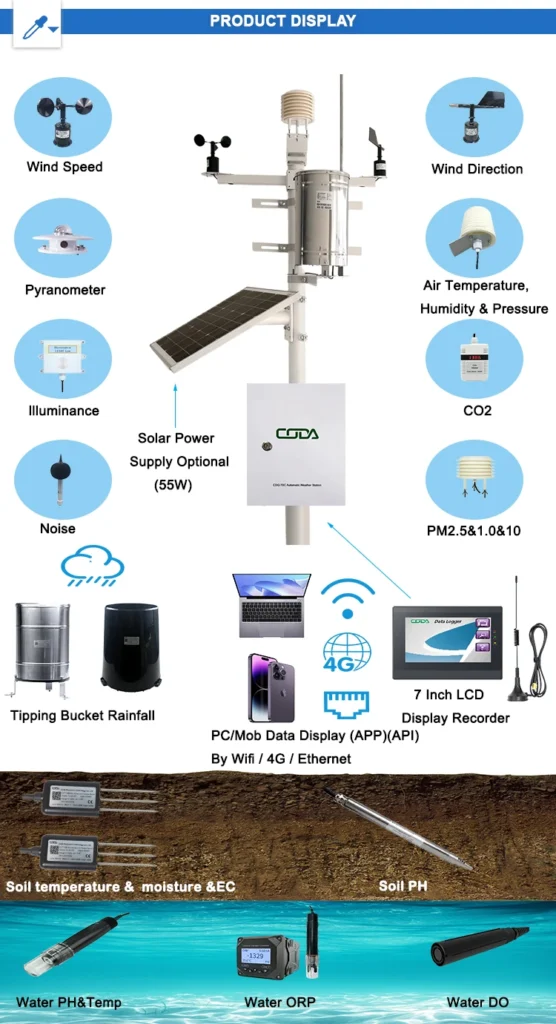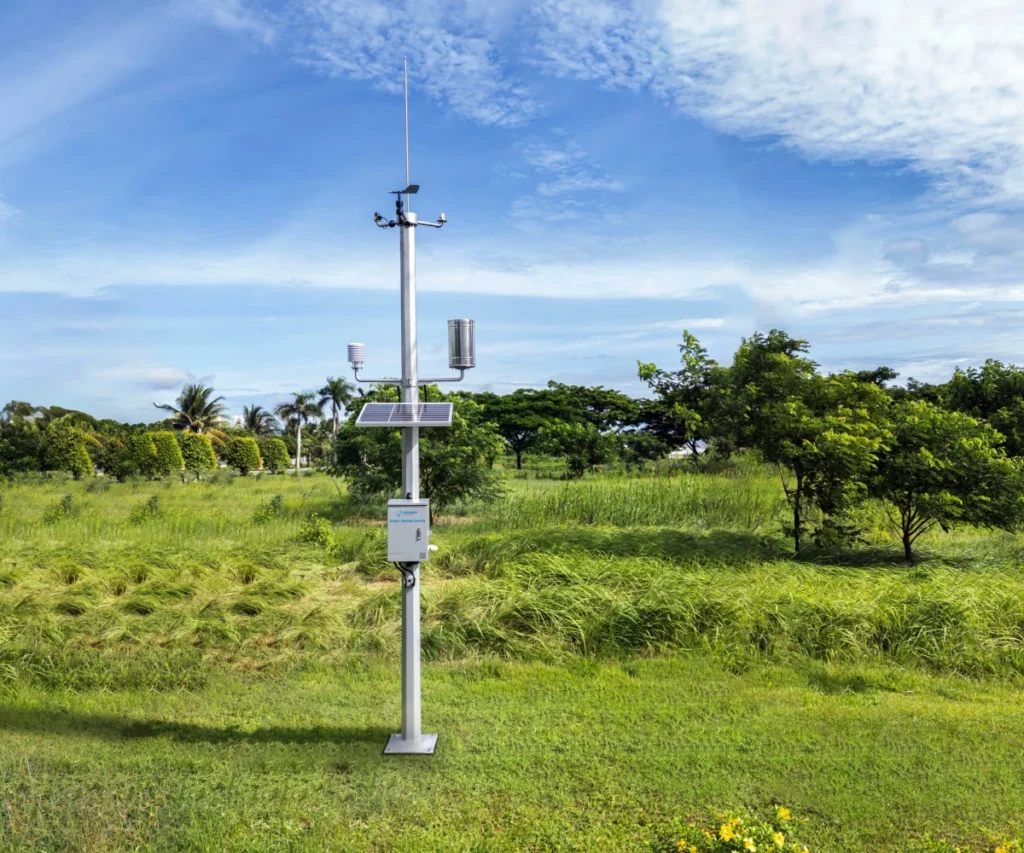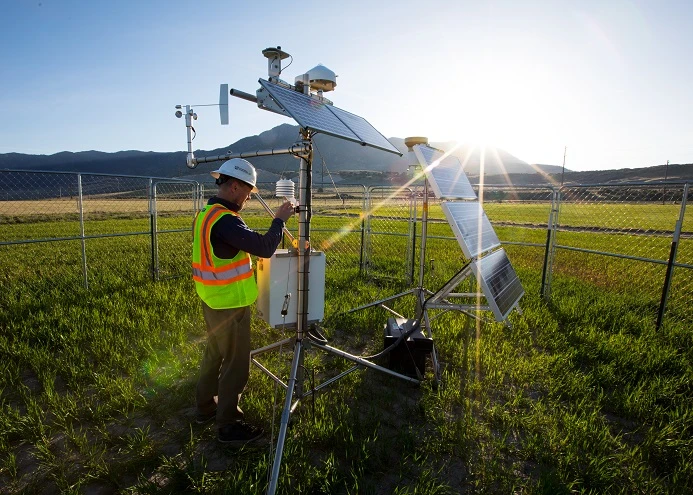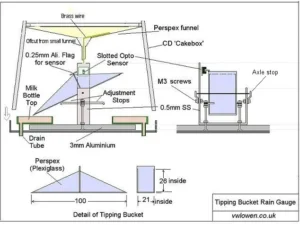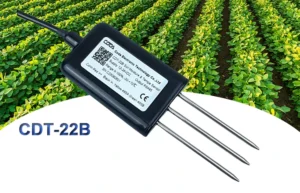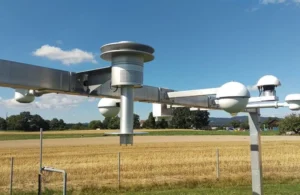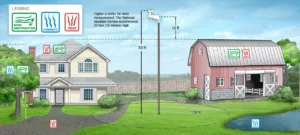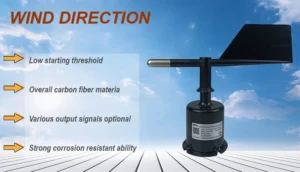Agricultural Automatic Weather Monitoring Station
An agricultural weather monitoring station has sensors that track different weather and environmental factors. The main types of sensors in these systems are:
Temperature Sensors
**Thermocouple Sensors:**
These sensors have two metal wires connected at each end. One end is called the measurement junction. We place this junction in the environment to measure temperature.
The other junction is the reference junction. A temperature difference between the two junctions creates a thermoelectric potential. We use this potential to find the temperature.
**Thermistor Sensors:**
A thermistor is a kind of resistor made from semiconductors. Its resistance changes a lot with temperature. We value these sensors for their high sensitivity, good stability, and small size.
In automatic weather stations for farming, we often use thermistor sensors. They measure the temperature of crops, greenhouses, and other key areas.
Humidity Sensors
**Capacitive Humidity Sensors:**
These sensors use a polymer film with a porous structure as the sensing element. Changes in air humidity cause water vapor to stick to or leave the film’s surface. This changes the film’s dielectric constant and its capacitance value.
By measuring this value, we can find out the air humidity levels. Capacitive humidity sensors are very accurate and respond quickly. They also have a wide measurement range, making them great for monitoring air humidity in farming.
**Resistive Humidity Sensors:**
These sensors measure humidity by detecting changes in the resistance of their sensing material. This material is usually a metal oxide or polymer.
When humidity goes up, the resistance goes down, and the opposite is also true. Resistive humidity sensors are known for their simple design and low cost. They are easy to maintain and are great for measuring soil and air humidity in farming.
Rainfall Sensors
**Tipping Bucket Rain Gauges:**
This rain gauge has a funnel to catch rain. It also has a tipping bucket and a counting device.
When we collect rainwater in the funnel, it fills the tipping bucket. When the bucket gets full, it tips over. This empties the bucket and makes a pulse signal. We count these signals to find out how much it rained.
We often use tipping bucket rain gauges in weather monitoring for agriculture. They are easy to use, accurate, and dependable.
**Ultrasonic Rainfall Sensors:**
Ultrasonic sensors use sound waves to measure rain. These devices send out ultrasonic waves that bounce back from raindrops. By timing how long it takes for the waves to return, the sensor can tell how close the raindrops are. It also measures how much rain is falling.
Ultrasonic rainfall sensors have many benefits. They work without contact, are very accurate, and respond quickly. This makes them great for tough weather conditions.
Wind Sensors
**Cup Anemometers**:
Cup anemometers are common tools for measuring wind speed. They have three or four round cups on a pole. When the wind blows, it makes the cups turn. The speed of the turn shows how fast the wind is blowing.
Agricultural weather monitoring stations often use cup anemometers. These devices have a simple design, are very reliable, and can measure a wide range of conditions.
**Wind Vanes**:
Wind vanes measure wind direction. They have a vane on a rotating axis that moves with the wind. This shows where the wind comes from.
We often use wind vanes with cup anemometers. This combination gives a better understanding of wind conditions in farming.
Solar Radiation Sensors
**Pyranometers**:
Pyranometers are used to measure total solar radiation. This includes both direct sunlight and diffuse radiation scattered in the air. They have a sensor head.
This head is usually made from a thermopile or a solar cell. It also has a signal processing unit.
The sensor changes solar energy into an electrical signal. We then use this signal to find out the radiation intensity.
We often use pyranometers in agricultural weather monitoring because they are very precise and stable. We especially use them to study how solar radiation impacts crop growth.
**Pyrheliometers**:
Pyrheliometers measure only direct sunlight. They have a tube that focuses sunlight onto a sensor. This sensor is usually a thermopile or a solar cell.
Pyrheliometers are better than pyranometers for measuring direct sunlight. Scientists and researchers often use them in studies and farming.
Soil Moisture Sensors
**Capacitance-Type Soil Moisture Sensors**:
These sensors detect the soil’s dielectric constant. This constant is linked to the soil’s water content. An electromagnetic signal from the sensor interacts with this constant. This interaction changes how the signal travels.
Farmers often use capacitance soil moisture sensors to monitor soil moisture. These sensors are accurate and respond quickly. They measure moisture without harming the soil.
**Time-Domain Reflectometry (TDR) Soil Moisture Sensors**:
TDR sensors measure soil moisture by sending an electromagnetic pulse through a waveguide. They track how long it takes for the pulse to travel through the soil and come back. The time delay shows the soil’s dielectric constant, which relates to its moisture level.
TDR sensors are known for their high accuracy and can measure moisture at different depths. They are great for detailed monitoring but are more expensive and need complex installation and operation.
Agricultural Monitoring Station Application
1. **Precision Agriculture**
1.1 **Variable Rate Application of Inputs**
Automatic Agricultural Weather Monitoring Stations give real-time data. This helps farmers apply fertilizers, pesticides, and water more precisely. In a big cornfield, soil nutrients and moisture can vary in different areas.
Farmers can use precision farming tools with weather station data, soil sensors, and GPS technology. These tools help them adjust how much they apply. In places with high soil moisture from recent rain, less irrigation is needed. In drier areas, they may need to use more water.
This method helps use resources wisely and reduces environmental risks from using too much.
1.2 **Yield Prediction**
Data from weather stations, past crop yields, and growth models can help predict yields. Important factors include temperature, rainfall, and sunlight during key crop growth stages.
For instance, if a weather station shows high temperatures during soybean flowering, it can hurt pod-setting rates. This may lead to lower yields. These insights help farmers make smart decisions. They can adjust post-harvest logistics or look for new markets based on expected changes.
2. **Agricultural Product Quality Management**
2.1 **Fruit Ripening and Quality Control**
Weather conditions have a big impact on fruit quality in orchards. In vineyards, grape sugar content and acidity matter for winemaking. These factors depend on temperature, sunlight, and rainfall.
Data from a farm monitoring station shows temperature changes, sunlight hours, and rainfall levels. This helps farmers adjust irrigation and fertilization for the best fruit ripening.
If rain is expected during the ripening period, farmers can take steps to protect their crops. They can cover the vines to reduce moisture. This helps keep sugar levels high and lowers the risk of fungal diseases.
2.2 **Post-Harvest Storage Conditions**
Weather affects how we store harvested crops. For example, potatoes should be kept at 4–5°C with 85–90% humidity. Weather station data can help predict changes in temperature and humidity.
This helps farmers change ventilation and temperature controls. If a cold front is coming, farmers can insulate storage areas. This protects potatoes from cold damage.
3. **Agricultural Ecosystem Protection**
3.1 **Erosion Control**
Soil erosion is a big problem in farming, especially on hills. Heavy rain can cause erosion, and we can track this with weather stations. When heavy rain is coming, farmers can take quick actions.
They can activate erosion-control structures like contour bunds or set up temporary barriers to catch sediment. Also, looking at long-term rainfall trends helps farmers plan for better soil conservation. This can include methods like terracing or planting cover crops in areas that are likely to erode.
3.2 **Water Resource Management in Wetlands**
In farming areas close to wetlands, managing water well is important for both farming and wetland health. Weather station data on rain, evaporation, and temperature helps us understand water availability.
For example, if temperatures rise, evaporation levels may increase. In this case, we can change irrigation practices. This will help prevent too much water from being taken from wetland sources.
This balance helps wetland health, which is important for wildlife habitats. It also supports flood control and water cleaning systems.
